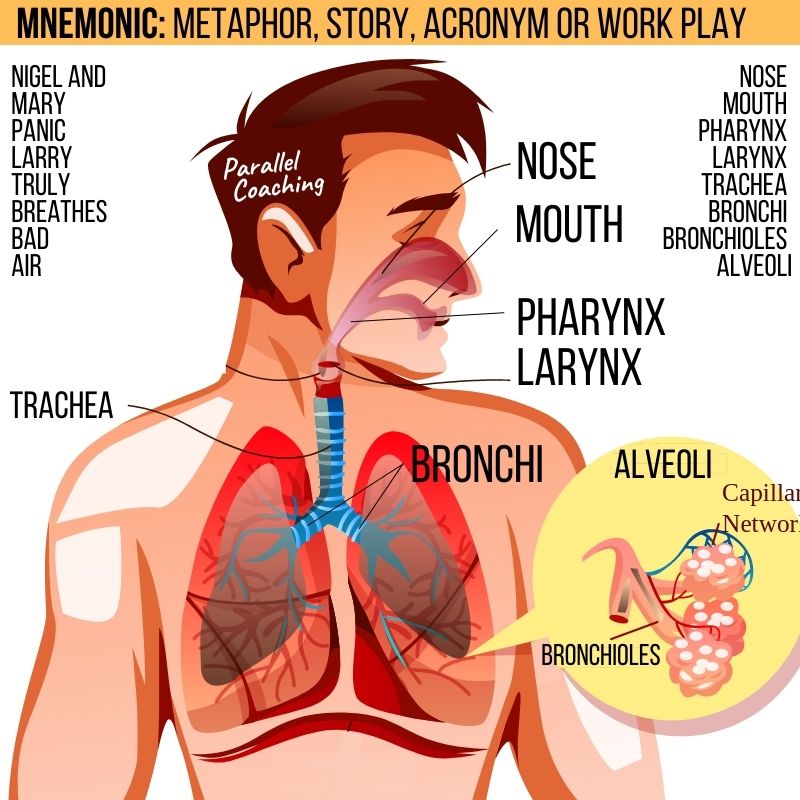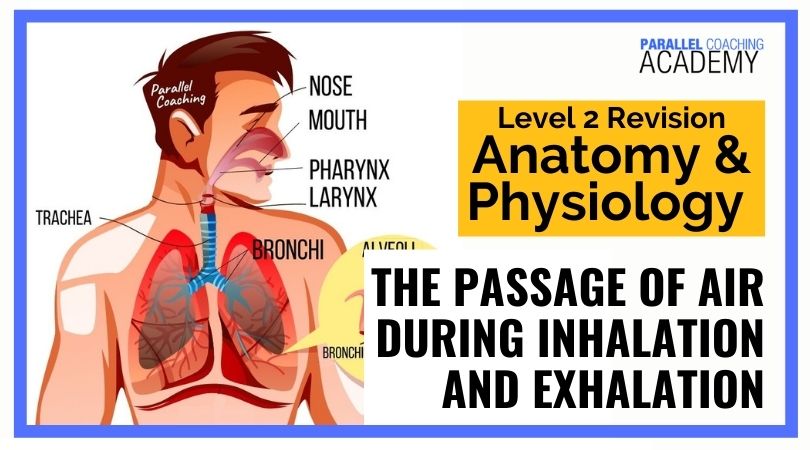It can be difficult to remember detailed processes like the Passage of Air on exam day. In today’s video, I’ll share a simple mnemonic, to make learning the respiratory system more enjoyable and improve your exam day memory.
Mnemonics are stories, acronyms, and wordplay that make it easier to remember information.
Today we are going to use a story about Nigel and Mary, to recall the Passage of Air During Inhalation. At the end of this video and blog scroll down to find three mock questions to test your knowledge
Watch the Full Video Tutorial Here:
before I teach you the story,
let’s find out why you need to know the passage of air
Anatomy refers to the parts of the body
and Physiology is how they function together
For each part of your Anatomy and physiology exam, you need to know the parts and how they work together.
There are 8 modules of content inside the Level 2 Anatomy and Physiology Exam, and Module 2 is all about the Respiratory System.
As part of this you need to understand The Passage of Air During Inhalation and Exhalation and be able to identify the function of each feature in the respiratory system.
This is the point whereby the respiratory system links up with the Cardiovascular system… and it starts to add context and clarity as to how our body functions as a whole.
Aside from the exam, it is really important to understand the breathing process. At the end of the day, we breathe all day every day. Our clients get “breathless” when they work out and we adopt specific “breathing patterns” for certain exercises.
Therefore in order to be able to coach our clients effectively and improve their performance, we need to know what all of our anatomical parts do, and how they work together
How to remember the Passage of Air During Inhalation and Exhalation?
Using a mnemonic makes learning and remembering your anatomy revision simpler. To learn the passage of air we are going to use a story about Nigel and Mary.
Imagine for a moment, two parents (Nigel and Mary), their son is called Larry and he works in the coal mines. They worry and panic that the air he breathes all day is not healthy for him.
That’s the story, simple and easy to picture
The mnemonic is:
Nigel and Mary, Panic, Larry Truly Breathes Bad Air
So you write down the first letter from each word.
When you write it out you’ll have
N, M, P, L, T, B, B, A
This then becomes the first letter of each stage in the Passage of Air (during inhalation)
- Nose
- Mouth
- Pharynx
- Larynx
- Trachea
- Bronchi
- Bronchioles
- Alveoli
Note that during Exhalation this process reverses, starting with Alveoli and ending with the nose and mouth
The image below shows this in action

Functions of each stage in the passage of air
Now you know all of the parts of the Respiratory System,. let’s understand the function of each part, and how they work together
The Nose is the primary method of taking in air, it filters the air we breathe, warming it and making it moister, which causes less irritation of the airways
The Mouth is a secondary method of taking air into the body. It is often used if our demand for oxygen has increased or the nasal cavity is obstructed.
The Pharynx is the cone-shaped space at the back of the throat, where the passage from nose and mouth meet.
The Larynx has four functions, the first is to protect the lower airways from any obstruction. However, it is also responsible for making sound (phonics), coughing, controlling ventilation, and creating the Valsalva maneuver.
The Trachea is approx 11cm long and is a clear tube pathway from the larynx down to the 5th thoracic vertebrae. Imagine this like a trunk of a tree.
The Bronchi are two thick branches that separate from the Trachea. There is a Left Bronchus and a Right Bronchus.
The Bronchioles are like smaller branches that protrude from the big Bronchi branches. They create a big surface area for the lungs by allowing for a complex network of branches.
Alveoli are small air sacs covered in capillaries. They look like grapes hanging from a tree, and they inflate and deflate with inhalation and exhalation.
The Oxygen-rich inhalation fills the alveoli, then via a process called DIFFUSION, Gaseous Exchange occurs, and oxygen is moved into the capillaries to join our Cardiovascular system and be circulated around the body through the blood.
Then Carbon dioxide is exchanged back into the alveoli from the capillaries, ready to be expelled from the lungs.
The whole process reverses, ending in us exhaling Carbon dioxide and other waste gases.
Test your knowledge with today’s Passage Of Air mock questions:
[NOTE: The answers are below the 3rd questions]
Q1: During inhalation where does air flow to after the Bronchi?
A. Alveoli
B. Bronchioles
C. Capillaries
D. Trachea
Q2: During exhalation where does air flow after the trachea?
A. Alveoli
B. Bronchi
C. Pharynx
D. Larynx
Q3: What is the name given to the process whereby oxygen moves from the alveoli to the capillaries?
A. Diffusion
B. Osmosis
C. Breathing
D. Pumping
Answers to the mock questions are :
Question 1= B, Question 2 = D, Question 3 = A
If you want more mock questions like this, then you can download more Free Mock Questions: DOWNLOAD NOW
Need More Help with your Level 2 Anatomy Revision?
For Trainee, FITPROS Taking Their L2 Anatomy & Physiology Exam.
Learn, Revise & Pass Your Level 2 Anatomy & Physiology Exam In Under 10-hours
(Without Having To Spend Hours Revising Or Feeling Overwhelmed)
If you want to get your revision structured, learn everything you need to know, and feel confident on exam day, then click the link below:

Dedicated to More
Hayley “The Passage of Air During Inhalation and Exhalation” Bergman
Parallel Coaching
P.S. You can also find us on the following platforms:
Instagram: Follow Now
Facebook: Like Our Page
Twitter: Tweet Us
YouTube: Subscribe Here
More Anatomy Revision Blogs: HERE

